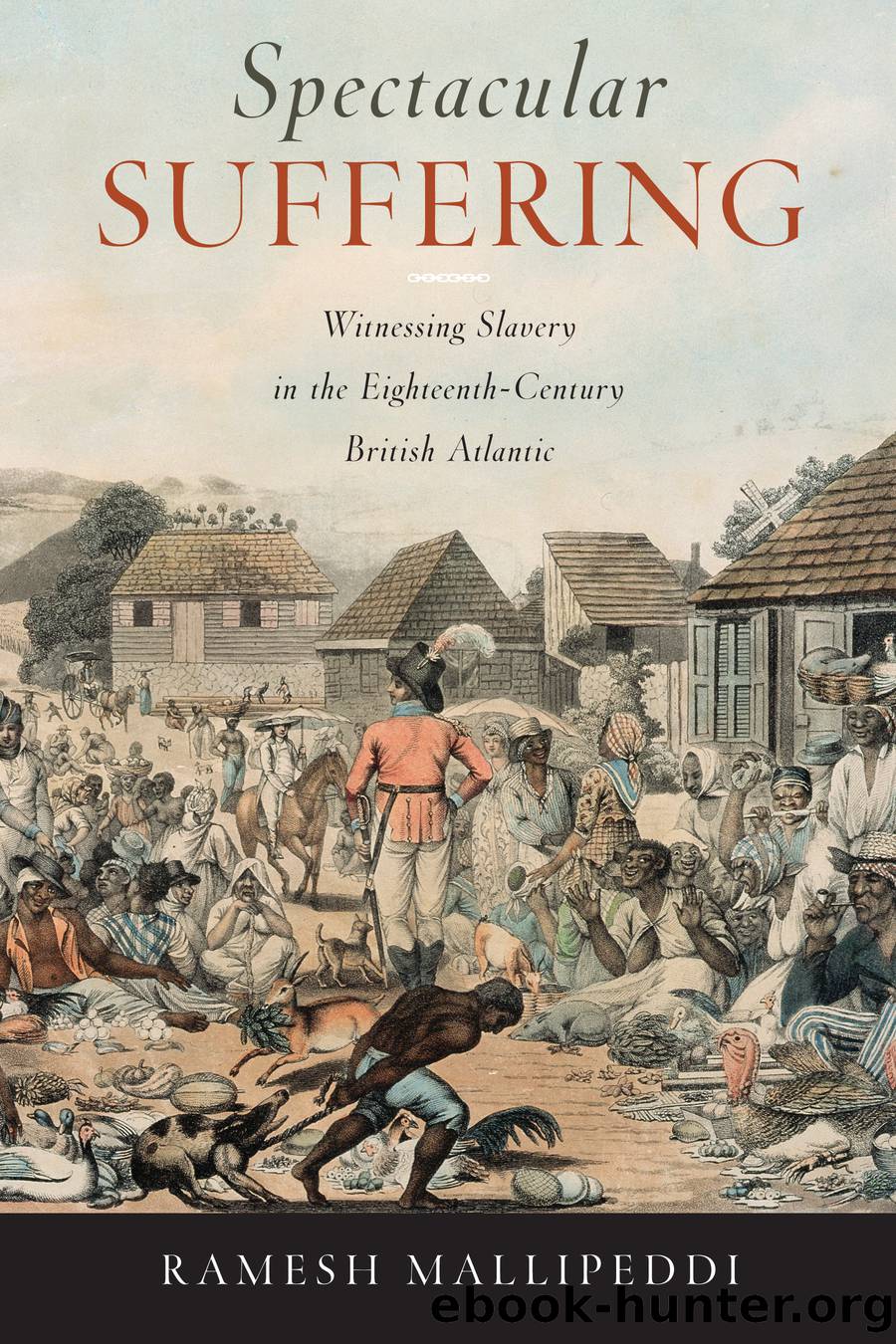Spectacular Suffering by Mallipeddi Ramesh;

Author:Mallipeddi, Ramesh;
Language: eng
Format: epub
Publisher: University of Virginia Press
Figure 7. âNegroes Sunday Market at Antigua,â W. E. Beastall, ca. 1806. (Private collection, © Michael Graham-Stewart/ Bridgeman Images)
Figure 8. âSunday Morning in the Country,â Richard Bridgens, from West India Scenery with Illustrations of Negro Character (London: R. Jennings, [1836?]), lithograph. (Yale Center for British Art, Paul Mellon Collection)
The contrast between slavesâ labor on the sugar plantationsâthat is, in commodity productionâand their work in provisioning and market exchange in sites of social reproduction is best understood through E. P. Thompsonâs famous distinction between timed and task-oriented labor.49 For Thompson, timed labor, performed for the benefit of the employer during the workday, is regular, monotonous, and alienating; conversely, task-oriented activity, undertaken for oneself, is purposive and irregular, lengthening or contracting according to the work at hand. Moreover, whereas time orientation is predicated on a separation between work and life, labor and social intercourse, in task orientation, these spheres intermingle and overlap. Although Thompson first proposes this distinction to explain work rhythms under industrial capitalism and although, under chattel slavery, task work was in fact time-oriented, this distinction nevertheless remains germane because the plantation was a place not only where slaves labored but also where they lived. The difference in the duration, pace, and organization of labor between the slavesâ experience of commodity production and of social reproduction could not be more pronounced: in the fields, slaves were divided into gangs according to age, sex, skills, and strength and toiled under the supervision of overseers to complete preassigned work. On the other hand, subsistence farming was largely unsupervised and the division of labor less rigid, with slaves tending to crops in family groups and performing a variety of tasks, including rest, the visiting of kin, and religious worship. The household, in short, was the unit of petty production. Similarly, the significance of marketing was simultaneously economic and social. Even as slaves were prohibited from leaving plantation estates without a pass on workdays, they were allowed, even during moments of unrest, to travel freely to marketsâto colorful, noisy, and riotous gatherings throughout the Caribbean. Slaves went not only to trade but also to meet friends and relatives, gossip, gamble, drink, and socialize. James Stuart, a longtime resident in the Caribbean, disapprovingly described the slave market as a âsort of hebdomadal carnival,â a place of sport, merriment, dissipation, and excess.50
Download
This site does not store any files on its server. We only index and link to content provided by other sites. Please contact the content providers to delete copyright contents if any and email us, we'll remove relevant links or contents immediately.
Women and Jewish Marriage Negotiations in Early Modern Italy by Howard Tzvi Adelman(380)
Warrior King by Wilbur Smith(324)
18 real-life stories of serial killers and murderers with solved and unsolved killings from the USA, UK, Europe, and beyond. by Ben Oakley(265)
Who's Who in the Zulu War, 1879: The British by Adrian Greaves Ian Knight(254)
Violence and Emotions in Early Modern Europe by Susan Broomhall;Sarah Finn;(240)
The Battle of Austerlitz by 50minutes(228)
The American Crisis by Unknown(224)
The Seeker by S. G. MacLean(203)
The Origins of French Absolutism, 1598-1661 by Alan James(200)
The Dutch East India Company and British East India Company: The History and Legacy of the Worldâs Most Famous Colonial Trade Companies by Charles River Editors(199)
Invisible Worlds by Peter Marshall(183)
The Traitor of Colditz by Robert Verkaik(182)
A Genius for Confusion by Richard M. Fried(182)
The Slave Trade in Africa by Simon Webb;(179)
Fires of Faith by Catholic England under Mary Tudor(177)
The Opium Wars: Exploring the Addiction of Empires from Beginning to End by Ramos Adrian & Compacted History(175)
Interest and Connection in the Eighteenth Century by Jacob Sider Jost(175)
The Thirty Years War â Complete by Friedrich Schiller(175)
Youth, Heroism and War Propaganda: Britain and the Young Maritime Hero, 1745â1820 by D. A. B. Ronald(175)
